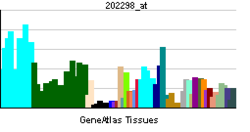- NADH dehydrogenase (ubiquinone), alpha 1
-
NADH dehydrogenase (ubiquinone) 1 alpha subcomplex, 1, 7.5kDa Identifiers Symbols NDUFA1; CI-MWFE; MWFE; ZNF183 External IDs OMIM: 300078 MGI: 1929511 HomoloGene: 3337 GeneCards: NDUFA1 Gene EC number 1.6.99.3 Gene Ontology Molecular function • NADH dehydrogenase (ubiquinone) activity Cellular component • mitochondrion
• mitochondrial inner membrane
• mitochondrial respiratory chain complex I
• mitochondrial respiratory chain complex I
• membrane
• integral to membrane
• mitochondrial membrane
• respiratory chainBiological process • mitochondrial electron transport, NADH to ubiquinone
• transport
• respiratory electron transport chainSources: Amigo / QuickGO RNA expression pattern 
More reference expression data Orthologs Species Human Mouse Entrez 4694 54405 Ensembl ENSG00000125356 ENSMUSG00000016427 UniProt O15239 Q545K0 RefSeq (mRNA) NM_004541 NM_019443.2 RefSeq (protein) NP_004532 NP_062316.1 Location (UCSC) Chr X:
119.01 – 119.01 MbChr X:
34.73 – 34.73 MbPubMed search [1] [2] NADH dehydrogenase [ubiquinone] 1 alpha subcomplex subunit 1 is a protein that in humans is encoded by the NDUFA1 gene.[1][2]
Function
The human NDUFA1 gene codes for an essential component of complex I of the respiratory chain, which transfers electrons from NADH to ubiquinone. It has been noted that the N-terminal hydrophobic domain has the potential to be folded into an alpha helix spanning the inner mitochondrial membrane with a C-terminal hydrophilic domain interacting with globular subunits of complex I. The highly conserved two-domain structure suggests that this feature is critical for the protein function and might act as an anchor for the NADH:ubiquinone oxidoreductase complex at the inner mitochondrial membrane. However, the NDUFA1 peptide is one of about 31 components of the "hydrophobic protein" (HP) fraction of complex I which is involved in proton translocation. Thus the NDUFA1 peptide may also participate in that function.[2]
References
- ^ Zhuchenko O, Wehnert M, Bailey J, Sun ZS, Lee CC (Mar 1997). "Isolation, mapping, and genomic structure of an X-linked gene for a subunit of human mitochondrial complex I". Genomics 37 (3): 281–8. doi:10.1006/geno.1996.0561. PMID 8938439.
- ^ a b "Entrez Gene: NDUFA1 NADH dehydrogenase (ubiquinone) 1 alpha subcomplex, 1, 7.5kDa". http://www.ncbi.nlm.nih.gov/sites/entrez?Db=gene&Cmd=ShowDetailView&TermToSearch=4694.
Further reading
- Smeitink J, van den Heuvel L (1999). "Human mitochondrial complex I in health and disease.". Am. J. Hum. Genet. 64 (6): 1505–10. doi:10.1086/302432. PMC 1377894. PMID 10330338. http://www.pubmedcentral.nih.gov/articlerender.fcgi?tool=pmcentrez&artid=1377894.
- Tretter L, Sipos I, Adam-Vizi V (2004). "Initiation of neuronal damage by complex I deficiency and oxidative stress in Parkinson's disease.". Neurochem. Res. 29 (3): 569–77. doi:10.1023/B:NERE.0000014827.94562.4b. PMID 15038604.
- Frattini A, Faranda S, Bagnasco L, et al. (1997). "Identification of a new member (ZNF183) of the Ring finger gene family in Xq24-25.". Gene 192 (2): 291–8. doi:10.1016/S0378-1119(97)00108-X. PMID 9224902.
- Loeffen JL, Triepels RH, van den Heuvel LP, et al. (1999). "cDNA of eight nuclear encoded subunits of NADH:ubiquinone oxidoreductase: human complex I cDNA characterization completed.". Biochem. Biophys. Res. Commun. 253 (2): 415–22. doi:10.1006/bbrc.1998.9786. PMID 9878551.
- Au HC, Seo BB, Matsuno-Yagi A, et al. (1999). "The NDUFA1 gene product (MWFE protein) is essential for activity of complex I in mammalian mitochondria.". Proc. Natl. Acad. Sci. U.S.A. 96 (8): 4354–9. doi:10.1073/pnas.96.8.4354. PMC 16336. PMID 10200266. http://www.pubmedcentral.nih.gov/articlerender.fcgi?tool=pmcentrez&artid=16336.
- Yadava N, Potluri P, Smith EN, et al. (2002). "Species-specific and mutant MWFE proteins. Their effect on the assembly of a functional mammalian mitochondrial complex I.". J. Biol. Chem. 277 (24): 21221–30. doi:10.1074/jbc.M202016200. PMID 11937507.
- Man PY, Brown DT, Wehnert MS, et al. (2002). "NDUFA-1 is not a nuclear modifier gene in Leber hereditary optic neuropathy.". Neurology 58 (12): 1861–2. PMID 12084895.
- Strausberg RL, Feingold EA, Grouse LH, et al. (2003). "Generation and initial analysis of more than 15,000 full-length human and mouse cDNA sequences.". Proc. Natl. Acad. Sci. U.S.A. 99 (26): 16899–903. doi:10.1073/pnas.242603899. PMC 139241. PMID 12477932. http://www.pubmedcentral.nih.gov/articlerender.fcgi?tool=pmcentrez&artid=139241.
- Gerhard DS, Wagner L, Feingold EA, et al. (2004). "The status, quality, and expansion of the NIH full-length cDNA project: the Mammalian Gene Collection (MGC).". Genome Res. 14 (10B): 2121–7. doi:10.1101/gr.2596504. PMC 528928. PMID 15489334. http://www.pubmedcentral.nih.gov/articlerender.fcgi?tool=pmcentrez&artid=528928.
- Mamelak AJ, Kowalski J, Murphy K, et al. (2005). "Downregulation of NDUFA1 and other oxidative phosphorylation-related genes is a consistent feature of basal cell carcinoma.". Exp. Dermatol. 14 (5): 336–48. doi:10.1111/j.0906-6705.2005.00278.x. PMID 15854127.
- Vogel RO, Dieteren CE, van den Heuvel LP, et al. (2007). "Identification of mitochondrial complex I assembly intermediates by tracing tagged NDUFS3 demonstrates the entry point of mitochondrial subunits.". J. Biol. Chem. 282 (10): 7582–90. doi:10.1074/jbc.M609410200. PMID 17209039.
- Fernandez-Moreira D, Ugalde C, Smeets R, et al. (2007). "X-linked NDUFA1 gene mutations associated with mitochondrial encephalomyopathy.". Ann. Neurol. 61 (1): 73–83. doi:10.1002/ana.21036. PMID 17262856.
Categories:- Human proteins
- Chromosome X gene stubs
Wikimedia Foundation. 2010.
